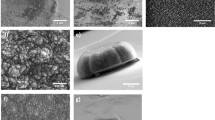Abstract
Growth of large area, single or almost single crystal diamond is of great importance to the electronics industry. In this work, single crystal diamonds were implanted with C+ ions, inducing a subsurface damage layer in the diamond lattice. Homoepitiaxial diamond films were then grown on the implanted crystals using a microwave plasma CVD reactor. Films grown on on-axis substrates were dominated by large numbers of hillocks, renucleation and penetration twins, while miscut substrates exhibited stepflow growth. The homoepitaxial layers were separated from the substrate by a water-based etch which selectively attacks the subsurface damage layer of the diamond lattice. The films were analyzed by Raman scattering, scanning electron microscopy (SEM), optical microscopy, photo- and cathodoluminescence, and x-ray diffraction. CVD growth on adjacent, oriented substrates formed a single, continuous diamond layer. The resulting homoepitaxial film quality, orientation, defect density and it’s relationship to the underlying substrates were compared at various points on the surface, particularly the region which overgrew the gap between different substrates.
Similar content being viewed by others
References
L.S.G. Plano, p. 100, in Diamond, Electronic Properties and Applications, ed. L.S. Pan, D.R. Kania, Kluwer Acad. Pub., Boston, (1995)
M.W. Geis, N.N. Efremow, R. Susulka, J.C. Twichell, K.A. Snail, C. Spiro, B. Sweeting, S. Holly, Diamond and Related Materials, 4, 76, (1994)
G. Janssen, L.J. Giling, Presented at Diamond Films, 94, il Ciocco, Italy, Sept., 1994, submitted to Diamond and Related Materials
N.R. Parikh, J.D. Hunn, E. McGuken, MX. Swanson, C.W. White, R.A. Rudder, D.P. Malta, J.B. Posthill, R.J. Markunas, Appl. Phys. Lett., 61, 3124 (1992)
M. Marchywka, P.E. Pehrsson, D.J. Vestyck, D. Moses, Appl. Phys. Lett., 63(25), 3521 (1993)
T.W. Mercer, P.E. Pehrsson, S.J. Potochnik, unpublished results
N. Lee, A. Badzian, Appl. Phys. Lett., 66(17), 2203 (1995)
W.J.P. van Enckevort, G. Janssen, J.J. Schermer, L.J. Giling, Diamond and Related Materials, 4, 250 (1995)
L.F. Sutcu, C.J. Chu, M.S. Thompson, R.H. Hauge, J.L. Margrave, M.P. D'Evelyn, J. Appl. Phys., 71(12), 5930 (1992)
J.E. Field, in The Properties of Natural and Synthetic Diamond. Ed. J.E. Field, Academic Press, London, (1992)
Acknowledgments
The authors thank Dan Vestyck for technical help with CVD growth, Raman spectroscopy, and laser cutting of the homoepitaxial layer.
Author information
Authors and Affiliations
Rights and permissions
About this article
Cite this article
Pehrsson, P.E., Mccormick, T., Alexander, W.B. et al. Homoepitaxial Mosaic Growth and Liftoff of Diamond Films. MRS Online Proceedings Library 416, 51–56 (1995). https://doi.org/10.1557/PROC-416-51
Published:
Issue Date:
DOI: https://doi.org/10.1557/PROC-416-51




